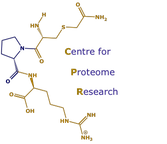Sequencing
Can you perform protein sequencing de novo?
14/05/15 09:40
Yes.
High quality sequencing de novo * is best achieved using an instrument that generates high mass accuracy precursor (peptide) and product (peptide fragment) ions. Thus, we would run such samples on the QExactive. Then, the datafile is best processed using Peaks (BSI) which does an excellent job of reconstructing peptide sequences from the ion series.
To see examples where we have almost completely sequenced a protein from species where genome/transcriptome data are unavailable of poor, see [here] or [here].
However, even with a complete set of tryptic peptides, fully sequenced, it is still impossible to define the order of the peptides. This can be overcome in one of two ways. First, if there is a protein from a related species of known sequence, it may be possible to use homology matching to assemble the tryptic peptide sequences. Alternatively, if the same protein is digested with a different endopeptidase (such as GluC) we can generate a second set of peptide sequences that overlap with the tryptic series, and which can be used to reconstruct the protein sequence. One final point - some peptides will be too small to sequence, and it can also be helpful to digest a protein with endopeptidases LysC or ArgC.
Using these approaches, we have completely sequenced proteins up to about 200 amino acids. There is no reason why this cannot be extended to larger proteins.
And, one final caveat. Leu and Ile are isobaric, and cannot be discriminated by this approach.
* I believe that it is formally correct to say 'sequencing de novo' rather than 'de novo sequencing'. This is akin to the common error of 'in vitro studies' which should be 'studies in vitro'. Classical scholars might wish to enlighten.
High quality sequencing de novo * is best achieved using an instrument that generates high mass accuracy precursor (peptide) and product (peptide fragment) ions. Thus, we would run such samples on the QExactive. Then, the datafile is best processed using Peaks (BSI) which does an excellent job of reconstructing peptide sequences from the ion series.
To see examples where we have almost completely sequenced a protein from species where genome/transcriptome data are unavailable of poor, see [here] or [here].
However, even with a complete set of tryptic peptides, fully sequenced, it is still impossible to define the order of the peptides. This can be overcome in one of two ways. First, if there is a protein from a related species of known sequence, it may be possible to use homology matching to assemble the tryptic peptide sequences. Alternatively, if the same protein is digested with a different endopeptidase (such as GluC) we can generate a second set of peptide sequences that overlap with the tryptic series, and which can be used to reconstruct the protein sequence. One final point - some peptides will be too small to sequence, and it can also be helpful to digest a protein with endopeptidases LysC or ArgC.
Using these approaches, we have completely sequenced proteins up to about 200 amino acids. There is no reason why this cannot be extended to larger proteins.
And, one final caveat. Leu and Ile are isobaric, and cannot be discriminated by this approach.
* I believe that it is formally correct to say 'sequencing de novo' rather than 'de novo sequencing'. This is akin to the common error of 'in vitro studies' which should be 'studies in vitro'. Classical scholars might wish to enlighten.
